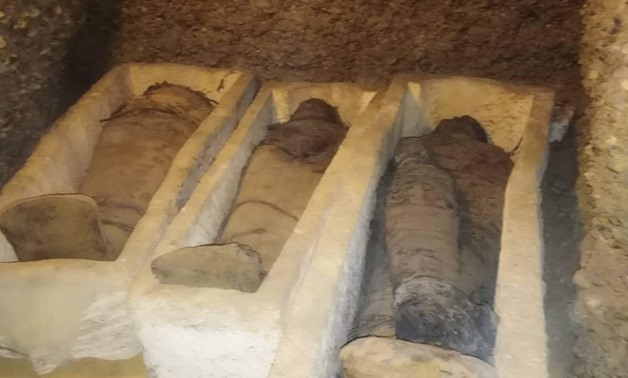https://www.egypttoday.com/Article/4/64250/All-you-need-to-know-about-cemeteries-uncovered-in-Tuna
 Two cemeteries discovered in Tuna el Gebel archaeological area in Minya governorate - Press photo
Two cemeteries discovered in Tuna el Gebel archaeological area in Minya governorate - Press photo All you need to know about cemeteries uncovered in Tuna El Gebel
By: Angy Essam
Mon, Feb. 4, 2019
Anany explained that foreign ambassadors said they are fond of mummies but it is a unique experience to be face-to-face with them in the archaeological site.
Anany added that the uncovered tombs are a familial grave which was probably for a family from the upper middle class. He explained that the discovery dates back to the beginning of the Roman era and the uncovered antique coffins date back to the late era.
Anany further explained that the newly uncovered grave consists of a number of burial chambers housing about 40 human mummies of different genders and ages, including children. All the discovered mummies are in a good condition where some are wrapped in linen or decorated with Demotic handwriting.
Head of the Supreme Council of Antiquites Mostafa Waziry explained that the techniques used to bury the mummies vary in style as some of the mummies were buried inside stone or wooden sarcophagi, while others were buried in sand or were placed on the floors of the tombs or inside niches.
This is the burial style used in Tuna El- Gebel, which was the necropolis of Egypt's 15th Nome during the late New Kingdom and the beginning of the New Intermediate Period.
Waziry added that fragments of papyri were also uncovered in the tomb, the matter that indicated that it could date to the Ptolemaic, early Roman and Byzantine periods.
Head of the archaeological mission Wagdi Ramadan said that the mission started its work in Tuna El-Gebel in February 2018.
Minister of Tourism Rania al-Mashat said that the this discovery is an important message to the whole world that Egypt "has it all."
The minister of tourism, the governor of Minya, the secretary-general of the Supreme Council of Antiquities, and ambassadors and cultural attachés from 11 foreign countries, including Malta, the Czech Republic, Spain, Serbia, Ireland, Belarus, and China, as well as the head of Minya University and parliamentarians from Minya all attended the announcement ceremony at the site.
Egypt Today exclusively revealed on January 27 the details of this discovery before being officially announced on February 2.
The minister previously announced on Feb. 24, 2018 the discovery of eight tombs that contain about 40 coffins of Pharaonic priests and more than 1,000 Ushabti statues in Tuna El-Gebel area in Minya governorate. The tombs were full of jewellery, potteries and jars.
Anany described this discovery as one of the largest and most important archaeological discoveries in recent times because it documents significant issues related to the live of ancient Egyptians in Minya tens of centuries ago.
The most prominent finds in these tombs were a gold mask, coffins, mummies and statues. The Egyptian minister of antiquities added that it will take a lot of hard work to uncover all Tuna El-Gebel's treasures, pointing out that the main advantage of this discovery is that it was made by Egyptians.
Furthermore, archaeologists at Cairo University have discovered catacombs including 18 non-royal mummies in Tuna El-Gebel on Saturday May 13, 2017. The burial shafts were found in the area and the shafts led to a number of corridors containing a cachet of mummies. This discovery was the first human necropolis found in central Egypt with so many mummies.
Tuna El-Gebel area is among the archaeological sites that contain plenty of ancient Egyptian treasures that are not yet revealed.
Tuna El-Gebel, in the city of Mallawi, was the necropolis of Khmun. It contains monuments from the Greek and Roman eras, as well as the Late Middle Ages. The area hosts the Boundary Stelae of Akhenaton, catacombs of falcons, baboons and ibises, and the tombs of Petosiris and Isadora.
Tuna El-Gebel was originally named "Towns" in the Pharaonic era and "Tahnet" in the Roman era. The meaning of both names is the blessing or flood.
-- Sent from my Linux system.
No comments:
Post a Comment